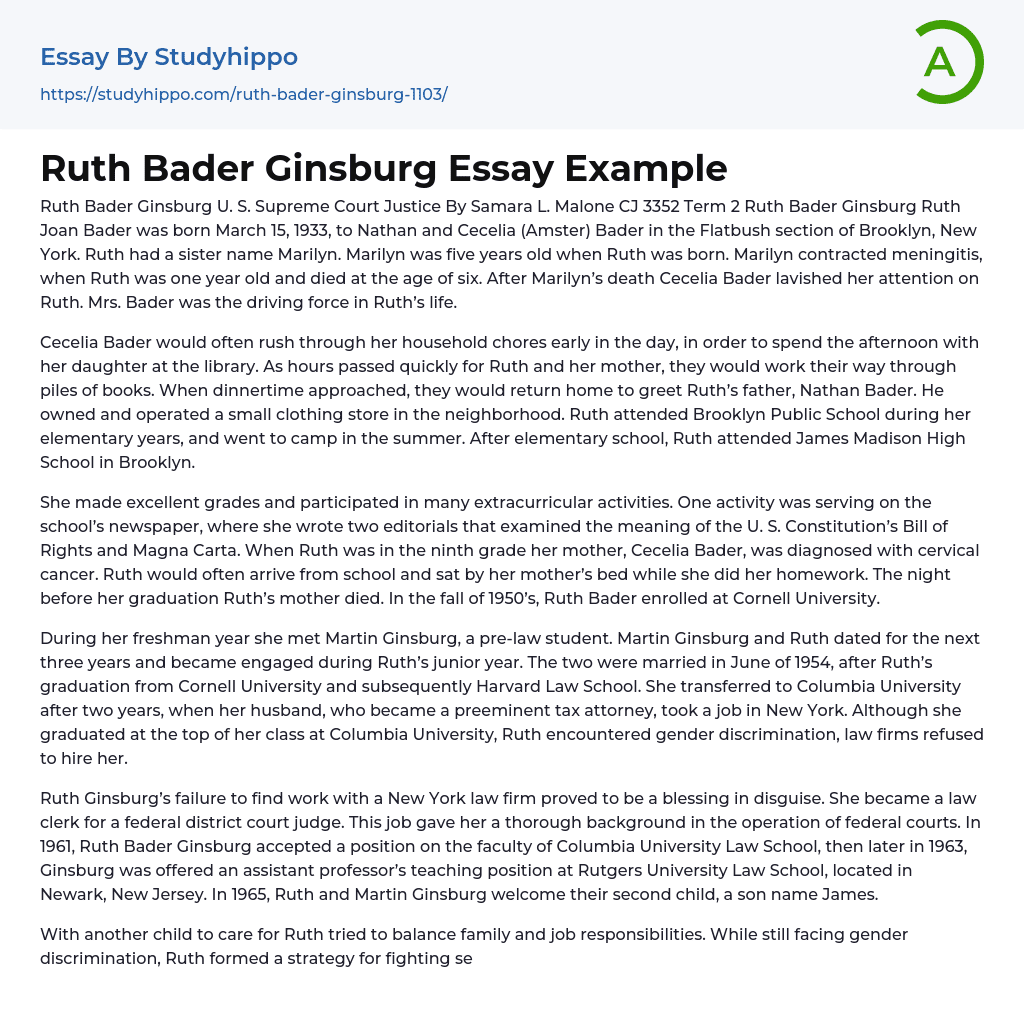Ruth Joan Bader was born March 15, 1933, to Nathan and Cecelia Bader in the Flatbush section of Brooklyn, New York. Ruth had a sister name Marilyn. Marilyn was five years old when Ruth was born. Marilyn contracted meningitis, when Ruth was one year old and died at the age of six. After Marilyn’s death Cecelia Bader lavished her attention on Ruth. Mrs. Bader was the driving force in Ruth’s life.
Cecelia Bader would often rush through her household chores early in the day, in order to spend the afternoon with her daughter at the library. As hours passed quickly for Ruth and her mother, they would work their way through piles of books. When dinnertime approached, they would return home to greet Ruth’s father, Nathan Bader. He owned and operated a small clothing store in the neighborhood. Ruth attended Brooklyn Public School d
...uring her elementary years, and went to camp in the summer. After elementary school, Ruth attended James Madison High School in Brooklyn.
She made excellent grades and participated in many extracurricular activities. One activity was serving on the school’s newspaper, where she wrote two editorials that examined the meaning of the U. S. Constitution’s Bill of Rights and Magna Carta. When Ruth was in the ninth grade her mother, Cecelia Bader, was diagnosed with cervical cancer. Ruth would often arrive from school and sat by her mother’s bed while she did her homework. The night before her graduation Ruth’s mother died. In the fall of 1950’s, Ruth Bader enrolled at Cornell University.
During her freshman year she met Martin Ginsburg, a pre-law student. Martin Ginsburg and Ruth dated for the next three years and became
engaged during Ruth’s junior year. The two were married in June of 1954, after Ruth’s graduation from Cornell University and subsequently Harvard Law School. She transferred to Columbia University after two years, when her husband, who became a preeminent tax attorney, took a job in New York. Although she graduated at the top of her class at Columbia University, Ruth encountered gender discrimination, law firms refused to hire her.
Ruth Ginsburg’s failure to find work with a New York law firm proved to be a blessing in disguise. She became a law clerk for a federal district court judge. This job gave her a thorough background in the operation of federal courts. In 1961, Ruth Bader Ginsburg accepted a position on the faculty of Columbia University Law School, then later in 1963, Ginsburg was offered an assistant professor’s teaching position at Rutgers University Law School, located in Newark, New Jersey. In 1965, Ruth and Martin Ginsburg welcome their second child, a son name James.
With another child to care for Ruth tried to balance family and job responsibilities. While still facing gender discrimination, Ruth formed a strategy for fighting sex discrimination through the court system. Ruth Ginsburg was the principal author of the organization’s legal argument, called a brief, for the case of Reed v Reed, which reached the U. S. Supreme Court in 1971. The case involved Sally Reed, who asked to administer the estate of her adopted son after his death in 1967. The law of Idaho, where the Reeds lived, gave priority to men over women in handling estates.
The state-appointed Reed’s husband, who was then separated from her, as the administrator of their son’s
estate. Ruth Ginsburg argued the Idaho Law violated the Fourteenth Amendment and in 1971, a unanimous Supreme Court agreed with Ginsburg’s argument and held the Idaho Law unconstitutional. After the 1971 Reed v. Reed decision, the ACLU formed a Women’s Rights Project, with Ruth Ginsburg as it first director. She argued six gender discrimination cases before the U. S. Supreme Court and won five of them.
Between 1973 and 1980, Ginsburg argued cases involving many different gender-based distinctions. In 1980, President Jimmy Carter named Ruth Ginsburg to the U. S. Court of Appeals for the District of Columbia. Ginsburg served 13 years until she was appointed by President Clinton in 1993 to the U. S. Supreme Court. Justice Ginsburg’s daughter, Jane Ginsburg Spera, at this time a law professor at Columbia University’s law school, shared her mother’s dream of a society in which women are not restricted because of their reproductive functions.
On learning of Ginsburg’s nomination to the Supreme Court, Spera reminded her mother that upon graduation from high school in 1973, Spera’s yearbook listed her ambition as “to see her mother appointed to the Supreme Court. ”
Citations
- Encyclopedia of world biography, 1997, edited by Suzanne Michele Bourgoin and Paula Kay Byers
- Women Chosen for Public Office, The Oliver Press, Inc, 1995, Josiah King House, 2709 Lyndale Avenue South, Minneapolis, MN 55408
- People to know, Ruth Bader Ginsburg, Supreme Court Justice; Enslow Publishers, Inc; Carmen Bredeson, 1995,
- Business Law essays
- Contract essays
- Consumer Protection essays
- Property essays
- Ownership essays
- Agreement essays
- Common Law essays
- Contract Law essays
- Justice essays
- Security essays
- Tort Law essays
- United States Constitution essays
- Crime essays
- Lawsuit essays
- Treaty essays
- Family Law essays
- Marijuana Legalization essays
- Constitution essays
- War on Drugs essays
- Court essays
- Jury essays
- Police essays
- Protection essays
- Community Policing essays
- Criminal Law essays
- Judge essays
- Lawyer essays
- Employment Law essays
- Copyright Infringement essays
- Injustice essays
- Intellectual Property essays
- Breach Of Contract essays
- Jurisprudence essays
- Social Injustice essays
- Juvenile Justice essays
- Internet Privacy essays
- Cyber Security essays
- Bill Of Rights essays
- Civil Liberties essays
- First Amendment To The United States Constitution essays
- Fourth Amendment To The United States Constitution essays
- Second amendment essays
- Animal Cruelty essays
- Law Enforcement essays
- Juvenile Justice System essays
- Surveillance essays
- Forensic Science essays
- Crime Prevention essays
- Criminal Justice essays
- Criminology essays




